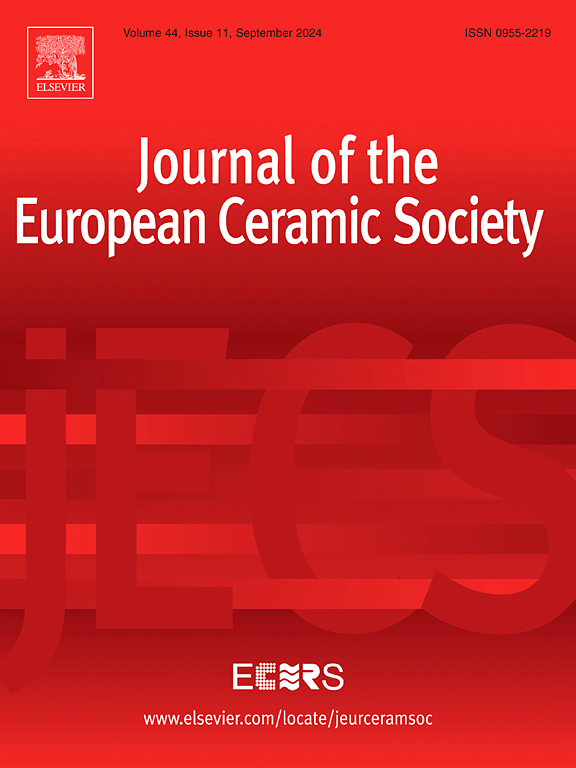Sr2+取代对CaNd2(MoO4)4陶瓷烧结性能和微波介电性能的影响
IF 5.8
2区 材料科学
Q1 MATERIALS SCIENCE, CERAMICS
Journal of The European Ceramic Society
Pub Date : 2025-06-24
DOI:10.1016/j.jeurceramsoc.2025.117641
引用次数: 0
摘要
采用传统的固相反应方法合成了一种新型低温烧结微波介质陶瓷CaNd2(MoO4)4,并对其微波介电性能、显微结构特征和化学键特征进行了系统研究。研究了用Sr2+取代Ca2+对样品(Ca1-xSrxNd2 (MoO4)4 (x = 0.01 - 0.09)的微波介电性能的影响。在820℃的烧结温度下,CaNd2(MoO4)4陶瓷呈现出空间群为I41/a的四方晶相,具有最佳的微波介电性能(εr = 10.4±0.06,Q×f = 71,000±2130 GHz, τf =−61.4±4.9 ppm/°C)。此外,通过痕量Sr2+取代,可以获得有限的固溶性和显著提高微波介电性能。在850℃下烧结的x = 0.05的组合物表现出最好的性能(εr = 11.9±0.07,Q×f = 105,000±3150 GHz, τf =−50.9±4.1 ppm/℃)。值得注意的是,Ca1-xSrxNd2 (MoO4)4陶瓷(x = 0和0.05)共烧后与Ag表现出良好的化学相容性。此外,基于P-V-L键理论和拉曼光谱的分析表明,优异的微波介电性能主要归因于晶格振动模式中Ca/ Nd-O键的主要贡献,它有效地抑制了本征介电损耗。这些优异的微波介电性能使所提出的陶瓷非常有希望成为高频LTCC应用的候选者。本文章由计算机程序翻译,如有差异,请以英文原文为准。
Effect of Sr2+ substitution on the sintering behavior and microwave dielectric properties of CaNd2(MoO4)4 ceramics
A novel low-temperature sintering microwave dielectric ceramic CaNd2(MoO4)4 was synthesized via a conventional solid-state reaction route and its microwave dielectric properties, microstructural characteristics, and chemical bond features were systematically investigated. The influence of substituting Ca2+ with Sr2+ in the specimen, denoted as Ca1–xSrxNd2(MoO4)4 (x = 0.01 – 0.09), on the microwave dielectric properties was also studied. The CaNd2(MoO4)4 ceramic exhibited a tetragonal crystalline phase with space group I41/a at a sintering temperature of 820 °C, delivering optimal microwave dielectric properties ( = 10.4 ± 0.06, Q×f = 71,000 ± 2130 GHz, = −61.4 ± 4.9 ppm/°C). Moreover, limited solid solubility and a significant enhancement in microwave dielectric properties were achieved through trace Sr2+ substitution. The composition with x = 0.05 sintered at 850 °C exhibited the most promising performance ( = 11.9 ± 0.07, Q×f = 105,000 ± 3150 GHz, = −50.9 ± 4.1 ppm/°C). Notably, Ca1–xSrxNd2(MoO4)4 ceramics (x = 0 and 0.05) demonstrated good chemical compatibility with Ag after co-firing. Furthermore, analysis based on P-V-L bond theory and Raman spectroscopy reveals that the superior microwave dielectric properties can be primarily attributed to the dominant contribution of Ca/Nd–O bonds in lattice vibrational modes, which effectively suppress intrinsic dielectric loss. These outstanding microwave dielectric properties make the proposed ceramics highly promising candidates for high-frequency LTCC applications.
求助全文
通过发布文献求助,成功后即可免费获取论文全文。
去求助
来源期刊

Journal of The European Ceramic Society
工程技术-材料科学:硅酸盐
CiteScore
10.70
自引率
12.30%
发文量
863
审稿时长
35 days
期刊介绍:
The Journal of the European Ceramic Society publishes the results of original research and reviews relating to ceramic materials. Papers of either an experimental or theoretical character will be welcomed on a fully international basis. The emphasis is on novel generic science concerning the relationships between processing, microstructure and properties of polycrystalline ceramics consolidated at high temperature. Papers may relate to any of the conventional categories of ceramic: structural, functional, traditional or composite. The central objective is to sustain a high standard of research quality by means of appropriate reviewing procedures.
 求助内容:
求助内容: 应助结果提醒方式:
应助结果提醒方式:


